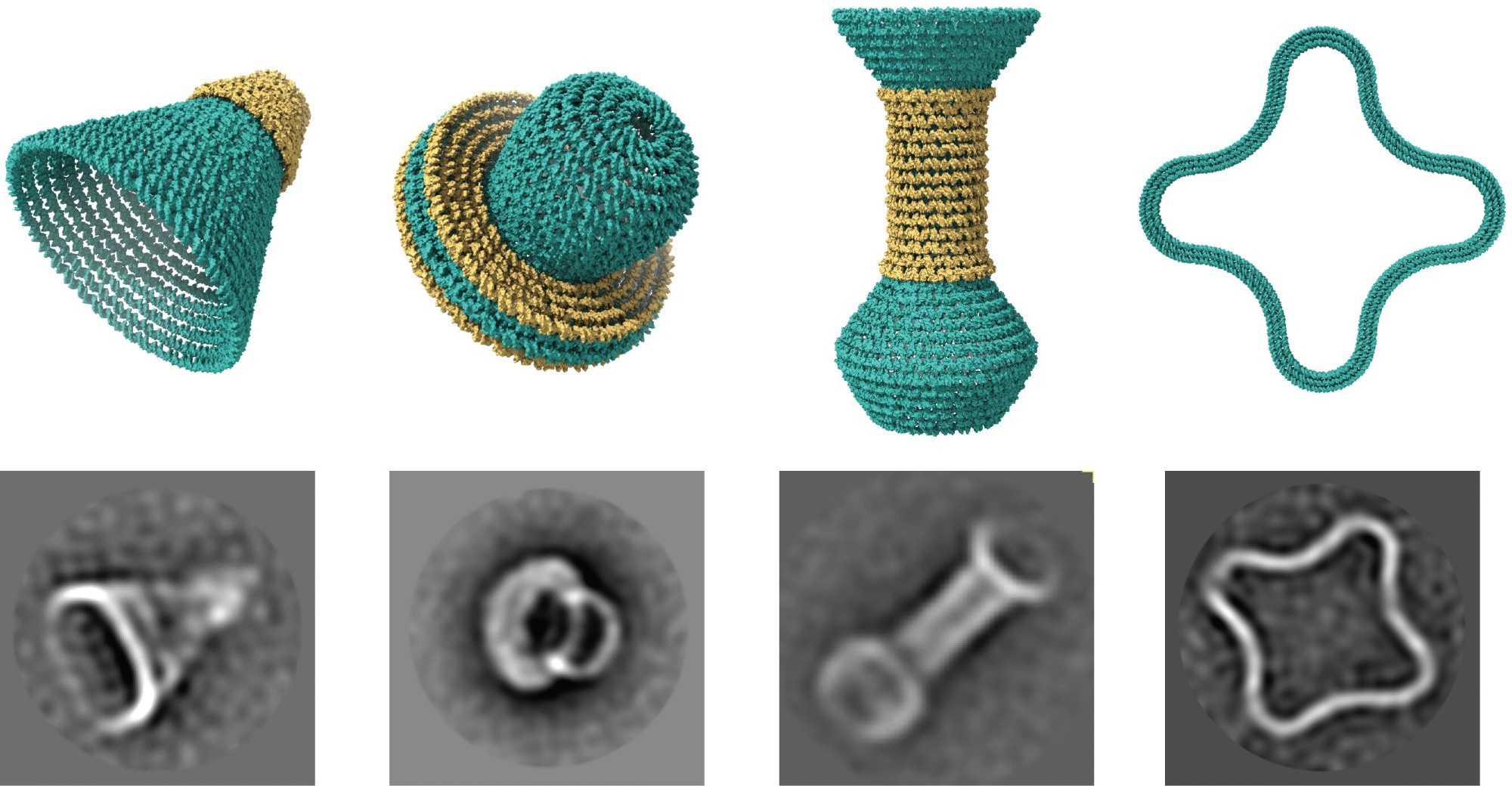DNA origami is a technique used for the nanoscale folding of DNA to develop two-dimensional (2D) and three-dimensional (3D) shapes at a nanoscale range.
 No bigger than a virus, each of these nanostructures was built using new software that lets researchers design objects out of concentric rings of DNA. Models (top) shown alongside electron microscope images of the actual objects (bottom). Credit: Raghu Pradeep Narayanan and Abhay Prasad, Yan lab, Arizona State University.
No bigger than a virus, each of these nanostructures was built using new software that lets researchers design objects out of concentric rings of DNA. Models (top) shown alongside electron microscope images of the actual objects (bottom). Credit: Raghu Pradeep Narayanan and Abhay Prasad, Yan lab, Arizona State University.
Improving the function of newly developed DNA nanostructures using curved geometries is significant, with the potential to positively enhance the application of DNA nanostructures in several research areas, including drug transport, nanofabrication, and molecular transport.
As reported in Science Advances, researchers from Duke University and Arizona State University have focussed on improving the existing DNA design principles to overcome the past challenges concerning the shape selection, accessibility, and mechanical rigidity of the 3D DNA nanostructures.
Development of DNA Origami
The underlying principle of the DNA origami technique is simple and consistent, which can produce spatially organized and self-assembled nanomaterials to better understand the nanoscale phenomenon.
In some cases, 3D DNA origami shapes are designed to serve as a separating barrier between the internal and external environment of the encapsulated object. DNA origami shapes and their respective design principles vary based on different algorithmic principles and synthesis conditions.
The wide-ranging applications of 3D DNA nanostructures are often restricted by the limitations associated with the existing DNA nanomolecular forms. Typically, for interdisciplinary applications, traditional techniques are used to create 3D DNA nanomaterials, where DNA helices are straight and parallel to a common vector. However, capsule-like functionality is required for optimal DNA nanostructures applications, achieved by developing rigid and hollowed DNA nanostructures.
Scientists designed capsule-like structures based on curved DNA helices to overcome this shortcoming. A curve motif could be aligned more precisely with globular or naturally occurring molecules, thereby achieving consolidating molecular activity. Another advantage of this technique is that the curvature offers a finer-grained discretization of the known geometry and location. Compared to the block-based design, the curvature method helps economically develop a closed-shaped DNA nanostructure with larger compartments.
Although there are numerous benefits associated with the new 3D DNA nanostructures possessing curved, stable, and completely enclosed features, the high level of complexities in their design restricts their easy accessibility to researchers. In addition, since the available design for the curved and enclosed DNA nanostructures are primarily single-layered, it affects their structural rigidity.
Development of Improved 3D DNA Origami Using DNAxiS
The new study focussed on improving the existing designing principle for developing enclosed, curved DNA nanostructures. It introduced a new Computer-aided design (CAD), called DNAxiS, which is the first software to automate the corresponding escalation in design tedium. This software is based on heuristic optimization algorithms.
The main working principle of DNAxiS is similar to the coils of clay to make a pot. DNA double-helical strands are coiled into concentric rings, which are stacked upon each other to form the contours of the object. To develop a robust DNA origami, researchers stacked additional layers onto the primary structure, which provided enhanced structural stability.
This multilayer design strategy helped to create various DNA forms, such as clover leaf shapes, cones, and gourds. These DNA shapes can be automatically formed using DNAxiS. The software uses specific algorithms to determine the position where the short DNA "staples" can be bound with longer DNA rings, such that they hold the specific shape properly.
Before the introduction of DNAixS, the short DNA strands were primarily bound in the wrong position of the longer DNA strand; as a result, incorrect DNA origami was formed. To develop a specific shaped DNA nanostructure, the software generates a list of DNA strands that can self-assemble to form the right configuration. After these DNA strands are synthesized and subsequently mixed in a test tube, they undergo relevant heating and cooling conditions to finally develop into the targeted DNA nanostructure form.
The present study provided a new strategy to develop novel DNA origami designs as freeform, oblique structures with novel geometries. These newly formed 3D DNA nanostructures can be applied in many research areas. The new multilayer design strategies have enabled the production of curved, closed DNA origami designs without any apparent algorithmic regularity to exploit.
To summarize, the new multilayer design strategies using DNAxiS can be applied in the production of the most beneficial curved DNA nanostructures that can be used in multiple areas of research. This strategy has enhanced the overall yield and stability of the curved DNA nanostructures by using multilayer design principles. Although the DNA design software has not yet been applied in clinics or laboratories, John Reif., an Author of the paper, notes, “it's a big step forward in terms of automated design of novel three dimensional structures.”
Reference
Fu, D. et al. (2022) Automated design of 3D DNA origami with non-rasterized 2D curvature. Science Advances, 8(51). DOI: 10.1126/sciadv.ade4455
Disclaimer: The views expressed here are those of the author expressed in their private capacity and do not necessarily represent the views of AZoM.com Limited T/A AZoNetwork the owner and operator of this website. This disclaimer forms part of the Terms and conditions of use of this website.